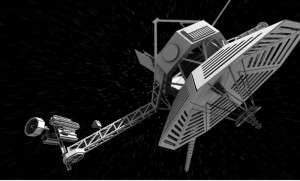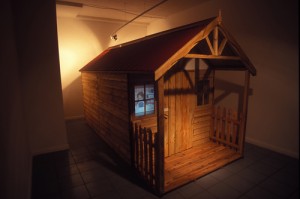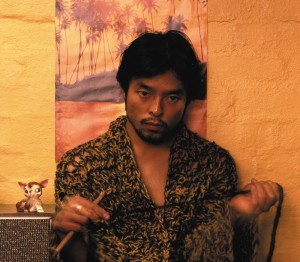Entering the Art Gallery of NSW to view the Anne Landa Award exhibition – the first Australian award for moving image and new media artists – I come upon what I think is one of the works.

Not My Voyager, Termination Shock, Peter Hennessey. Piezo pring on archival paper. Courtesy of the artist and Tolarno Galleries, Melbourne.
A large, striking recreation of the Voyager probe by Peter Hennessey accompanied by a projection of giant cockroaches secreted between gallery floors. Having not yet read the catalogue or gleaned much from the wall text, I stand and ponder the possible relations between these things. Upon climbing to the 1st floor to view the exhibition proper, I find they are actually from two different works – the probe is part of Hennessey’s My Voyager, but the massive cockroaches are the creation of Craig Walsh. I should have known. Walsh has long inserted large-scale video images into architectural spaces to great effect, and this example – Contested Space - is no exception. The intention of the work – viewed as a layer between the horizontal concrete supports of the ground and 1st floors like some Jurassic rock sample – is pretty simply illuminated by its title and works well in the space. As does Hennessey’s Voyager, floating in the high-ceilinged foyer. Their proximity to each other in this entry space gives a glimpse of the mix of sculptural and screen-based content of the exhibition, but it does little to contextualise either piece.
The other components of Hennessey’s work are a smaller sculptural copy of the Voyager and digital video projection of outer space, with audio recorded in Fitzroy, Melbourne. He has taken the Voyager’s embassy – to communicate the variety of life on earth to extra-terrestrials – and put a local spin on it by sampling, in various languages, Fitzroy residents’ messages to potentially interested aliens. This does a rather watery job of communicating the multi-cultural reality of Australian society, but the idea does lead to contemplation of what we think of nowadays as ‘alien’. The video shows pieces of broken-up probe floating through space, and I’m not sure whether this suggests the hubris of the Voyager embassy – as the wall text cites – or the futility of both NASA’s and Hennessey’s own exercise. Although I like the work’s presentation, overall I find its cited ‘subtle politics’ underdeveloped.

Play With Me, 2002, Van Sowerwine. Interactive installation. Courtesy of the artist.
A form of self-expression – capoiera, the self-defence moves disguised as dance developed by slaves in Brazil – plays itself out in Shaun Gladwell’s Woolloomooloo (Night). A lone female figure performs in the forecourt of a petrol station, at times still and contemplative, then writhing and air-punching, inside this ‘non-space of super modernity’ (Marc Augé, cited in the wall text). The image is (a/e)ffective, though I am a little tired of seeing the ‘non-space’ of the petrol station in art works. Gladwell has an overall project in the traditional sense of pursuing a common theme through his practice – street culture and the oppositional use of urban spaces – and this work is a sound addition to that larger whole. However, it would be good to see him upping the ante in terms of complexity in order to push his investigation to another level.
Guy Benfield’s Exploring Pain/Electric Wheelchair Boogaloo is also an exercise in video and performance, in the form of absurdist action painting. The video document’s the contorted actions of artist and assistant as they inch around the space in a wheelchair, using their bodies and buckets to smear paint everywhere. I like the spontaneous paint mess that is the result, and I enjoy seeing the process, which is complicated by the intention of exploring movement in a wheelchair. However, I’m not convinced there is any meaningful realisation of this intention – it’s seems much more boogaloo than exploration of pain.
Van Sowerwine’s work Play With Me successfully marries the sculptural and screen-based through an engaging little doll’s house that the viewer enters to interact with screen character Flora. By playing with Flora, her tea set and toys, we can affect rather troubling behaviour involving self-mutilation and actions indicating possible sexual abuse. The work’s interactive options do well to evoke questions of just how adults transfer their desires onto children, but a stronger narrative base might help the piece along. Many adults laugh at the results they affect in this work, which perhaps indicates a need for a more tightly controlled scenario.

Untouchable, 2003, David Rosetzky. 3 screen digital video installation. Installation view, ACCA Melbourne, 2003. Courtesy Kaliman Gallery, Sydney, Sutton Gallery, Melbourne.
David Rosetzky’s work Untouchable does not shy from a narrative base, with three pairs of characters articulating emotionally charged experiences, creating a triptych of personal stories. The piece evolves when the characters begin to recite each other’s lines, communicating Rosetzky’s desire to question representation and commonality of experience. I was cagey initially when I found the characters also engage in a dance routine, but the work actually really comes together at this point by aligning the characters and distancing us from the hitherto confessional style of the piece. Untouchable is well resolved conceptually, with range of emotion and distance of engagement, and as usual Rosetzky’s formal concerns are well realised. The artist is a deserving winner of the inaugural award (AUS$25,000) and the work will now form part of the AGNSW collection.
The Anne Landa Award is a welcome initiative in terms of supporting new media practitioners through financial and professional development – lets hope it provides a long-term opportunity to promote a wide variety of works and processes.
Jacqueline Bosscher
The Anne Landa Award Exhibition was held at the Art Gallery of NSW from 22 August – 9 September 2004
Read More
http://www.artgallery.nsw.gov.au/
Watch More
Some of Craig’s later work, Incursion, 2008
 This work is licensed under a Creative Commons Attribution-NonCommercial-ShareAlike 2.5 Australia.
This work is licensed under a Creative Commons Attribution-NonCommercial-ShareAlike 2.5 Australia.






